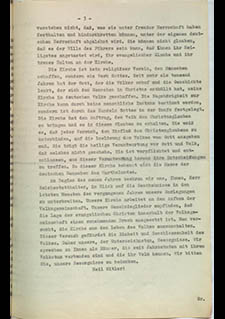Protest against the Churches’ Disenfranchisement
The plans to convert the “Reichsgau Wartheland” – “Warthegau” for short – into a “model Nazi Gau” also had consequences for the church. Given numerous prominent Party members’ anti-Christian and ant-ecclesiastical views, the churches in the Warthegau were unsurprisingly supposed to be forced into a marginal existence monitored by the state.
Reich Minister of Church Affairs, Hanns Kerrl, attempted to bring his influence to bear in the Warthegau, too, but he was vigorously denied the opportunity. He was stripped of any authority in the Warthegau. Its separation was finalized when the “13 Points” were presented orally to the consistory of Posen July 10, 1940.
Various Protestant church committees promptly lodged protests against these measures. Those affected especially protested quite emphatically. Various representatives of the church approached Reich Governor Greiser on January 18, 1941 and apprised him of the concern among all of the Germans.
Churchgoers were experiencing a deep shock and they could hardly believe that the actions were in keeping with the Führer’s intentions. Church is not a religious association and bears sacred accountability before God and Volk (Gürtler, National Socialism, p. 218). Greiser was asked to resist the attempt to eliminate churches from the lives of the people so that the unity and cohesion of the Volk is not jeopardized (Ibid., p. 219).
Since this petition – like a few others – was to no avail, General Superintendent Blau turned directly to Hitler on April 3, 1941. The congregations were deeply unsettled by the intended change of the church’s position in the lives of the people (Ibid., p. 230). Ties to the mother church had always been maintained during Polish rule and now the church in the Warthegau was supposed to organize itself independently. Blau entreated the Führer, in view of the grave concerns burdening thousands of faithful Protestant German men and women, to postpone the reorganization at least until the end of the war.
The Protestant High Consistory in Berlin also intervened on behalf of the church in the Warthegau. A letter of May 8, 1941 to Lammers, Head of the Reich Chancellery, one of July 23 to the Reich Minister of the Interior and one of September 26 to Hitler directly went unanswered.
Even the Religious Liaison Committee, which had long dismissed the developments in the Warthegau as something distinctive to the region, recognized their fundamental significance in mid-1941. A letter of July 23 to the Reich Minister of the Interior vigorously demanded his intervention; he was asked to rescind the Reich Governor’s decrees. The Religious Liaison Committee additionally supported the Prussian High Consistory’s petition to Hitler with a telegram on October 8:
The German Protestant parishes in the Wartheland, which have proven themselves in the struggle for Volkstum, living peacefully and true to the faith of their fathers, are supposed to be turned into a privatized association according to the Reich Governor of Posen’s decree of September 13, separated from the German mother church and simultaneously completely subjected to government supervision that would deeply impinge on religious life. The gravity and greatness of our age make baseless, forcible and worrisome experiments of this kind incomprehensible. In the name of German Protestant Christendom, which sees the fate of its member churches in the East its own, we therefore most urgently request that you to command that the Posen decree not be put into practice (Ibid., p. 86f.).
All of the protests were unsuccessful, however. The Head of the Reich Chancellery notified the High Consistory on November 11, 1941 that the Führer expressly endorsed the Reich Governor’s decree.
Source / title
- © Evangelisches Zentralarchiv in Berlin, Bestand 7 No. 18682



